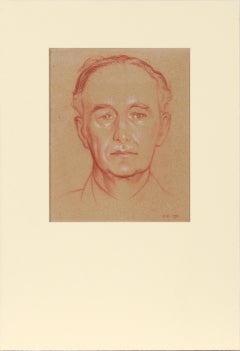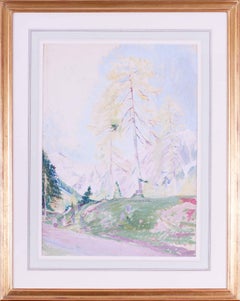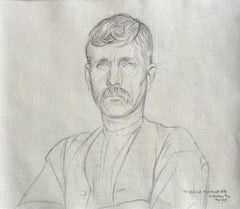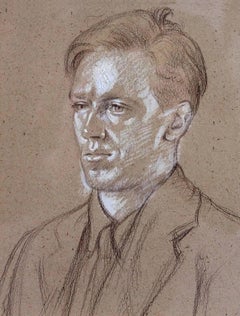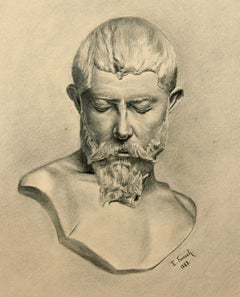Sir William Rothenstein Art
English, 1872-1945
William Rothenstein was born into a German-Jewish family in Bradford, West Yorkshire. Rothenstein left Bradford Grammar School at the age of sixteen to study at the Slade School of Art, London (1888-1893), where he was taught by Alphonse Legros, and the Académie Julian in Paris (1889-1893), where he met and was encouraged by James McNeill Whistler, Edgar Degas and Henri Toulouse-Lautrec. Whilst in Paris he also befriended the Anglo-Australian artist Charles Conder, with whom he shared a studio in Montmartre. In 1893 he returned to England to work on "Oxford Characters" a series of lithographic portraits.
In Oxford he met and became a close friend of the caricaturist and parodist Max Beerbohm, who later immortalised him in the short story Enoch Soames (1919). During the 1890s Rothenstein exhibited with the New English Art Club and, in 1900, won a silver medal for his painting The Doll's House at the Exposition Universelle. In 1898 he co-founded the Carfax Gallery in St. James' Piccadilly with John Fothergill. Carfax Gallery exhibited the work of Auguste Rodin, whose growing reputation in England owed much to Rothenstein's friendship and missionary zeal. The gallery was later the home for all three exhibitions of The Camden Town Group, led by Rothenstein's friend and close contemporary Walter Sickert.
Rothenstein is best known for his portrait drawings of famous individuals and for being an official war artist in both World War I and World War II. He was also a member of the International Society of Sculptors, Painters & Gravers. Examples include Parting at Morning (1891), Mother and Child (1903) and Jews Mourning at a Synagogue (1907) - all of which are owned by the Tate Gallery. The National Portrait Gallery owns over two hundred of his portraits. In 2011 the BBC and the Public Catalogue Foundation began cataloguing all of his paintings in public ownership online.
Between 1902 and 1912 Rothenstein lived in Hampstead, London. During this period Rothenstein worked on a series of important paintings in the predominantly Jewish East End of London, some of which were included in the influential 1906 exhibition of Jewish Art and Antiquaries at the Whitechapel Gallery.
Rothenstein was Principal of the Royal College of Art from 1920 to 1935, where he encouraged figures including Edward Burra, U Ba Nyan and Henry Moore. Moore was to later to write that Rothenstein 'gave me the feeling that there was no barrier, no limit to what a young provincial student could get to be and do'. His collections of portrait drawings include Oxford Characters (1896), English Portraits (1898), Twelve Portraits (1929) and Contemporaries (1937). He wrote several critical books and pamphlets, including Goya (1900; the first English monograph on the artist), A Plea for a Wider Use of Artists & Craftsmen (1916) and Whither Painting (1932). During the 1930s he published three volumes of memoirs: Men and Memories, Vol I and II and Since Fifty. Rothenstein was knighted in 1931.to
3
1
4
1
1
1
Portrait of Leopold Myers by Sir William Rothenstein
By Sir William Rothenstein
Located in Soquel, CA
Stately sanguine portrait of Leopold Hamilton Myers (Novelist) by Sir William Rothenstein (English, 1872-1945). Captured in Rothenstein's characteristic style, Myers looks directly at the viewer with a neutral expression. Although this portrait uses only two colors and minimal shading, the likeness of Myers is incredibly well captured. Leo (Leopold) Hamilton Myers (1881 – 1944) was a British novelist. Numerous examples like this one of the writer are in the Tate Museum.
Initialed and dated in the lower right corner ("W.R. 1936")
Inscription on verso indicating materials, subject, and artist.
Presented in a new cream colored mat with foamcore backing.
Mat size: 18"H x 12"W
Paper size: 15.25"H x 10.75"W
William Rothenstein (English, 1872-1945) was born into a German-Jewish family in Bradford, West Yorkshire. His father, Moritz, emigrated from Germany in 1859 to work in Bradford's burgeoning textile industry. Soon afterwards he married Bertha Dux, and they had six children, of which William was the fifth. Rothenstein was knighted in 1931.
Rothenstein left Bradford Grammar School at the age of sixteen to study at the Slade School of Art*, London (1888-1893), where he was taught by Alphonse Legros, and the Académie Julian* in Paris (1889-1893), where he met and was encouraged by James McNeill Whistler, Edgar Degas and Henri Toulouse-Lautrec. Whilst in Paris he also befriended the Anglo-Australian artist Charles Conder, with whom he shared a studio in Montmartre. In 1893 he returned to England to work on "Oxford Characters" a series of lithographic* portraits.
In Oxford he met and became a close friend of the caricaturist* and parodist Max Beerbohm, who later immortalised him in the short story Enoch Soames (1919). During the 1890s Rothenstein exhibited with the New English Art Club* and, in 1900, won a silver medal for his painting The Doll's House at the Exposition Universelle. In 1898 he co-founded the Carfax Gallery in St. James' Piccadilly with John Fothergill. During its early years the gallery was closely associated with such artists as Charles Conder, Philip Wilson Steer, Charles Ricketts and Augustus John. It also exhibited the work of Auguste Rodin, whose growing reputation in England owed much to Rothenstein's friendship and missionary zeal. The gallery was later the home for all three exhibitions of The Camden Town Group*, led by Rothenstein's friend and close contemporary Walter Sickert.
Rothenstein is best known for his portrait drawings of famous individuals and for being an official war artist in both World War I and World War II. He was also a member of the International Society of Sculptors, Painters & Gravers. The style and subject of his paintings varies, though certain themes reappear, in particular an interest in 'weighty' or 'essential' subjects tackled in a restrained manner. Good examples include Parting at Morning (1891), Mother and Child (1903) and Jews Mourning at a Synagogue (1907) - all of which are owned by the Tate Gallery. The National Portrait Gallery owns over two hundred of his portraits. In 2011 the BBC and the Public Catalogue Foundation began cataloguing all of his paintings in public ownership online.
Between 1902 and 1912 Rothenstein lived in Hampstead, London, where his social circle included such names as H.G.Wells, Joseph Conrad and the artist Augustus John. Amongst the young artists to visit Rothenstein in Hampstead were Mark Gertler...
Category
1930s Realist Sir William Rothenstein Art
Materials
Conté, Handmade Paper
British, 1922, gouache landscape by Sir William Rothenstein
By Sir William Rothenstein
Located in Petworth, West Sussex
Sir William Rothenstein (British, 1872-1945)
Mountain landscape
Signed and dated `W. Rothenstein 22’ (lower right)
Gouache
20.3/8 x 15 in. (51.8 x 38 cm.)
Provenance: Christie’s London, Modern British Paintings, 31 October 1996, lot 2
The English portrait artist Sir William Rothenstein was born January 29, 1872, near Bradford, Yorkshire. William Rothenstein was the son of Moritz Rothenstein, who came to England from Hanover in 1859, and the brother of Charles Lambert Rutherston, the collector, and Albert Daniel Rutherston, the artist. William Rothenstein studied for one year at the Slade School in London under Alphonse Legros, after which he spent four years in Paris, where he attended the Académie Julian. While in Paris, Rothenstein met many of the important artists of the time; he was particularly influenced by James Whistler, Edgar Degas, and Henri Fantin-Latour. After his return to England in 1893, Rothenstein was commissioned by John Lane...
Category
20th Century English School Sir William Rothenstein Art
Materials
Paper, Gouache
Portrait of Edward Johnston
By Sir William Rothenstein
Located in London, GB
Sir William Rothenstein
1872-1945
Portrait of Edward Johnston
Graphite on paper, signed, dated and inscribed lower right
Image size: 7 9/10 x 9 inches (20 x 23 cm)
Acid free mount
I...
Category
Early 20th Century Sir William Rothenstein Art
Materials
Paper, Graphite
Portrait of Cecil Day Lewis 20th Century Original Chalk Drawing
By Sir William Rothenstein
Located in London, GB
Sir William Rothenstein
1872 - 1945
Portrait of Cecil Day Lewis
Black and white chalk on paper
Image size: 13 ½ x 9 inches
Period gilt frame
Category
20th Century Sir William Rothenstein Art
Materials
Paper, Chalk
Related Items
"Self Portrait Conte Sketch" rare Ben Fenske work on paper - academic study
By Ben Fenske
Located in Sag Harbor, NY
A colorful self-portrait from Ben Fenske, staring at the viewer straight-on. Hues of red dominate.
Unframed.
Ben Fenske (b. 1978) although a native of Minnesota, and has been worki...
Category
Early 2000s Academic Sir William Rothenstein Art
Materials
Paper, Conté
$1,200
H 25.5 in W 19 in
Sketch of a head - Carved in stone -
Located in Berlin, DE
Emil Faesch (1865 Basel - 1915 Basel). Sketch of a head. Charcoal on painting cardboard, 60 x 47.5 cm (folio size), signed and dated at lower right "E. Faesch. 1888.".
Minor browning.
- Carved in stone -
About the artwork
The life-size head has an immensely present presence. This effect is due to the fact that Faesch took his cue from academic classical...
Category
1880s Realist Sir William Rothenstein Art
Materials
Chalk
$427 Sale Price
20% Off
H 23.63 in W 18.9 in D 0.4 in
Untitled (Man Reclining on Tile Floor)
By Mark Beard
Located in New York, NY
Graphite and conté crayon on paper
Signed and dated, l.r.
This artwork is offered by ClampArt, located in New York City.
Mark Beard, born in 1956 in Salt Lake City, now lives in Ne...
Category
1970s Realist Sir William Rothenstein Art
Materials
Paper, Graphite, Conté
A Grand Tour view of St Peter's Rome, Roman Campagna, Italy
By Thomas Hartley Cromek
Located in Harkstead, GB
A wonderful view of St Peter's, Rome encompassing the elegant landscaped gardens with rolling campagna in the background.
Attributed to Thomas Hartley Cromek...
Category
Mid-19th Century English School Sir William Rothenstein Art
Materials
Paper, Watercolor
$452 Sale Price
30% Off
H 7 in W 9.75 in D 1 in
"Self Portrait Sketch" Early conte crayon drawing, head of Ben Fenske, unframed
By Ben Fenske
Located in Sag Harbor, NY
An early work on paper, by American Impressionist painter, Ben Fenske. It's rare to see a drawing like this from Fenske, especially of a self portrait. Fenske uses classical draftin...
Category
Early 2000s Academic Sir William Rothenstein Art
Materials
Paper, Conté
Cliffs, Dorset
Located in Middletown, NY
Watercolor on watercolor paper, 9 3/4 x 12 1/4 inches (248 x 311 mm), the full sheet. Scattered light toning, especially at the sheet edges. Minor, light area of clustered brown spot...
Category
Mid-19th Century English School Sir William Rothenstein Art
Materials
Watercolor
Jurassic Coast, Dorset
Located in Middletown, NY
Watercolor on heavy gauge watercolor, 4 1/8 x 11 3/4 (105 x 299 mm), the full sheet. In good condition with scattered minor surface soiling, and light scattered foxing. Colors slight...
Category
Mid-19th Century English School Sir William Rothenstein Art
Materials
Watercolor
The Loving Couple
By Charles Angrand
Located in Paris, Île-de-France
Circle of Charles Angrand (1854-1926)
The Loving Couple
Pencil and stump on paper,
30 x 22 cm
Dated "10.4.19" lower left. Trace of a dedication
Otherwise unsigned.
Provenance:
Pr...
Category
1910s Post-Impressionist Sir William Rothenstein Art
Materials
Conté, Carbon Pencil
Schooner beached on the moors at sunset, Nothe Fort in the distance, Dorset.
Located in Middletown, NY
Watercolor on cream wove paper mounted to light weight card stock, 3 3/4 x 5 1/2 inches (94 x 138 mm), the full sheet. In good condition with minor uniform toning.
Sophia Beale was...
Category
Late 19th Century English School Sir William Rothenstein Art
Materials
Watercolor, Board, Handmade Paper
Gardens, Exeter
Located in Middletown, NY
Watercolor with graphite on heavy gauge watercolor paper, 9 3/4 x 7 1/4 inches (249 x 185 mm), the full sheet. Titled and dated August 27, 1896 in pencil in the lower right margin. I...
Category
Late 19th Century English School Sir William Rothenstein Art
Materials
Watercolor, Board, Graphite
Self Portrait, of the Gentleman himself
By Francis Luis Mora
Located in New York, NY
A simply marvelous drawing - a self-portrait of the artist himself. It also reads as a very elegant and expressive line drawing of any gentleman - a hallmark depiction of a bon-vi...
Category
Early 20th Century American Realist Sir William Rothenstein Art
Materials
Archival Paper, Graphite
Interior still life, Beaumont
Located in Middletown, NY
Watercolor on heavy gauge watercolor paper, 14 x 9 3/4 inches (352 x 248 mm), the full sheet. Titled in pencil in the lower left margin. With a garden landscape in watercolor on the ...
Category
Late 19th Century English School Sir William Rothenstein Art
Materials
Watercolor
Sir William Rothenstein art for sale on 1stDibs.
Find a wide variety of authentic Sir William Rothenstein art available for sale on 1stDibs. You can also browse by medium to find art by Sir William Rothenstein in paper, chalk, conté and more. Not every interior allows for large Sir William Rothenstein art, so small editions measuring 9 inches across are available. Customers who are interested in this artist might also find the work of William Edward Frost, John Sergeant, and Adriaan Lubbers. Sir William Rothenstein art prices can differ depending upon medium, time period and other attributes. On 1stDibs, the price for these items starts at $879 and tops out at $7,669, while the average work can sell for $3,250.
